How To Draw A Great Dane Face
If yous want to draw lifelike portraiture, knowing how to describe facial features is essential. Below, creative person and instructor Lee Hammond shares tips and techniques for drawing realistic faces with graphite pencil, excerpted from her book, Lee Hammond's All New Big Book of Drawing .
In this step-past-step guide, Lee will teach you how to recreate every attribute of your model'southward confront: the optics, nose, cheeks, and mouth. So you lot sympathize where we're heading in this tutorial, here's our finished product showtime.
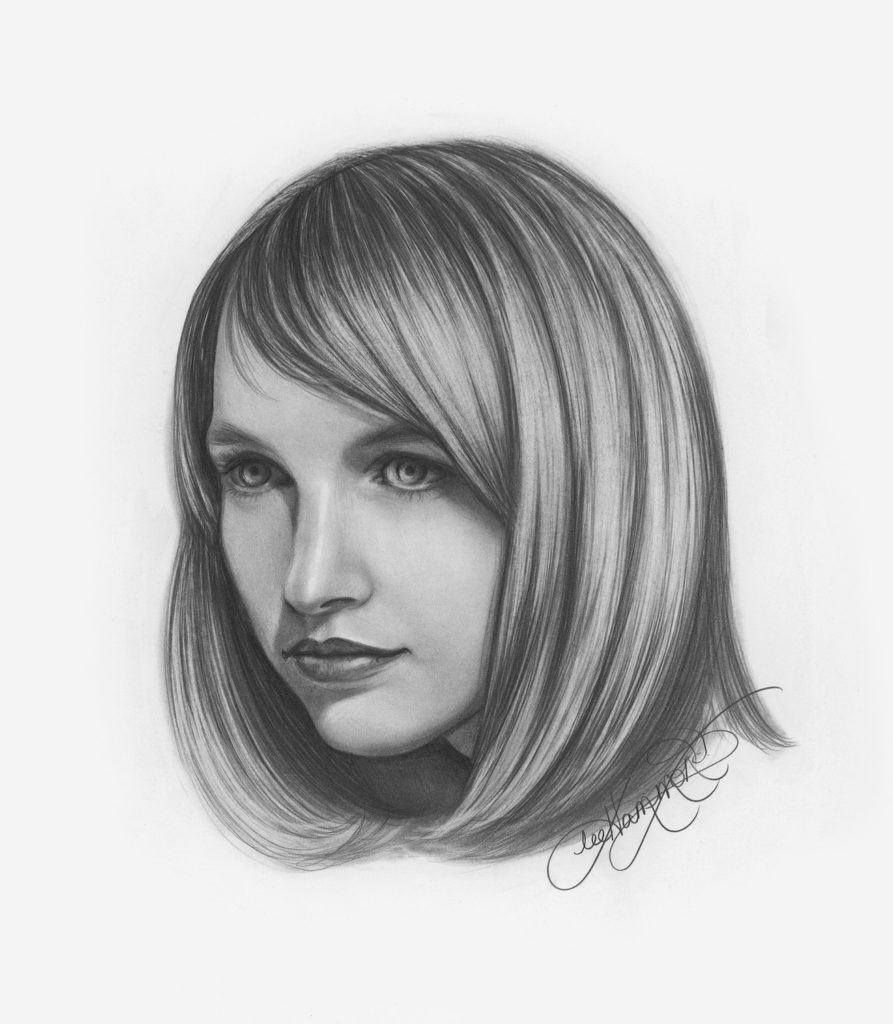
More Resources on Cartoon Faces and People
Video Lesson: How to Draw an Center
Drawing the Curve of Cheeks, Chins, and Noses Drawing Hair
Cartoon Facial Hair Avoid These 5 Mistakes When Drawing Portraits
Learning to Draw Facial Features
Now, before yous can depict an entire face, you must commencement learn to depict each of the facial features individually. But by taking i feature at a time tin you acquire the anatomy well and understand what to look for and what to capture in your drawing.

Cartoon Noses 2 Ways
The nose is the least complicated feature and most closely resembles the sphere, as noted. The five elements of shading are easy to meet. Information technology is important to learn to draw facial features in different poses.
These direct-on and profile views of the nose will give you ample do. Follow the steps to draw a nose in both views.
Drawing a Olfactory organ: Straight-on View
ane. Create a Line Drawing
Use the filigree method and a mechanical pencil to create a line cartoon of a nose in a directly-on view.
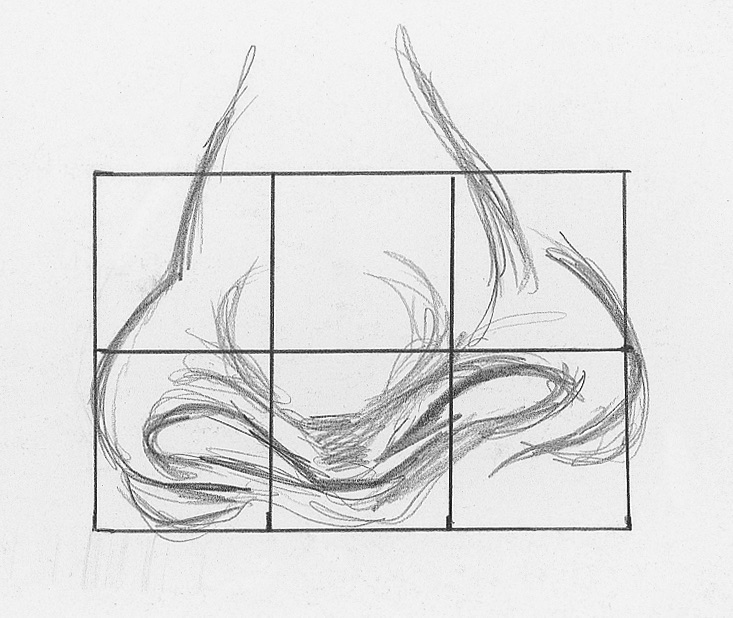
ii. Develop the Lights and Darks
First and foremost, when you are certain of your accuracy, carefully remove the grid lines with a kneaded eraser. Then, develop the patterns of lite and night with a pencil. Start by drawing a sphere to acquire lifelike shading and facial curves.
2nd, add reflected light along the edges of the olfactory organ and the rim of the nostril. Add a shadow border under the tip of the olfactory organ to make it look rounded. Place cast shadows under the bottom edge of the nose.
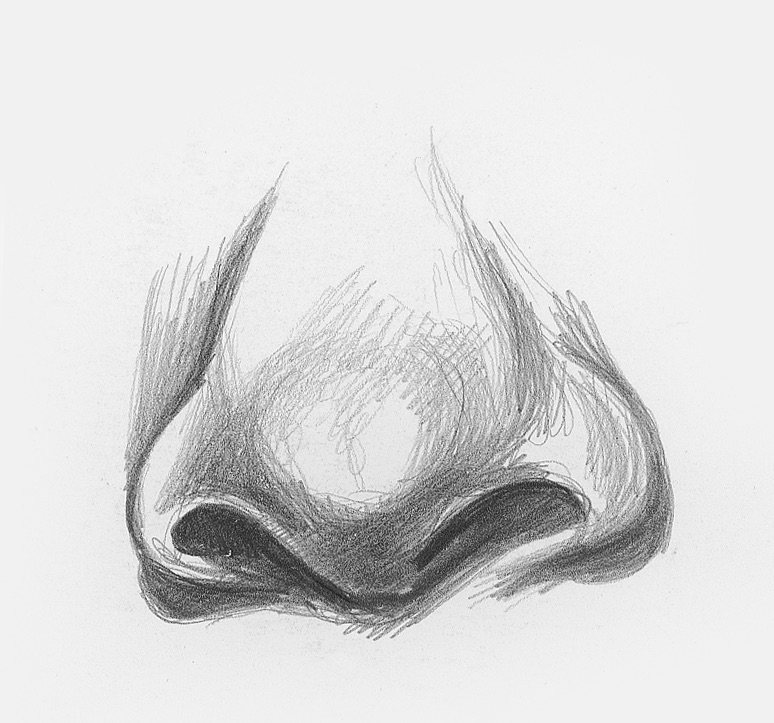
3. Alloy
After you add together your lite and dark tones, alloy them smoothen with a stump or tortillion. Very lilliputian of the drawing should be left white. Many artists will leave skin tones also lite, but merely the highlights should be as white as the paper.
Be sure to blend out from the dark areas into the lighter face area, just like you lot did in the sphere practice. This makes information technology appear real.
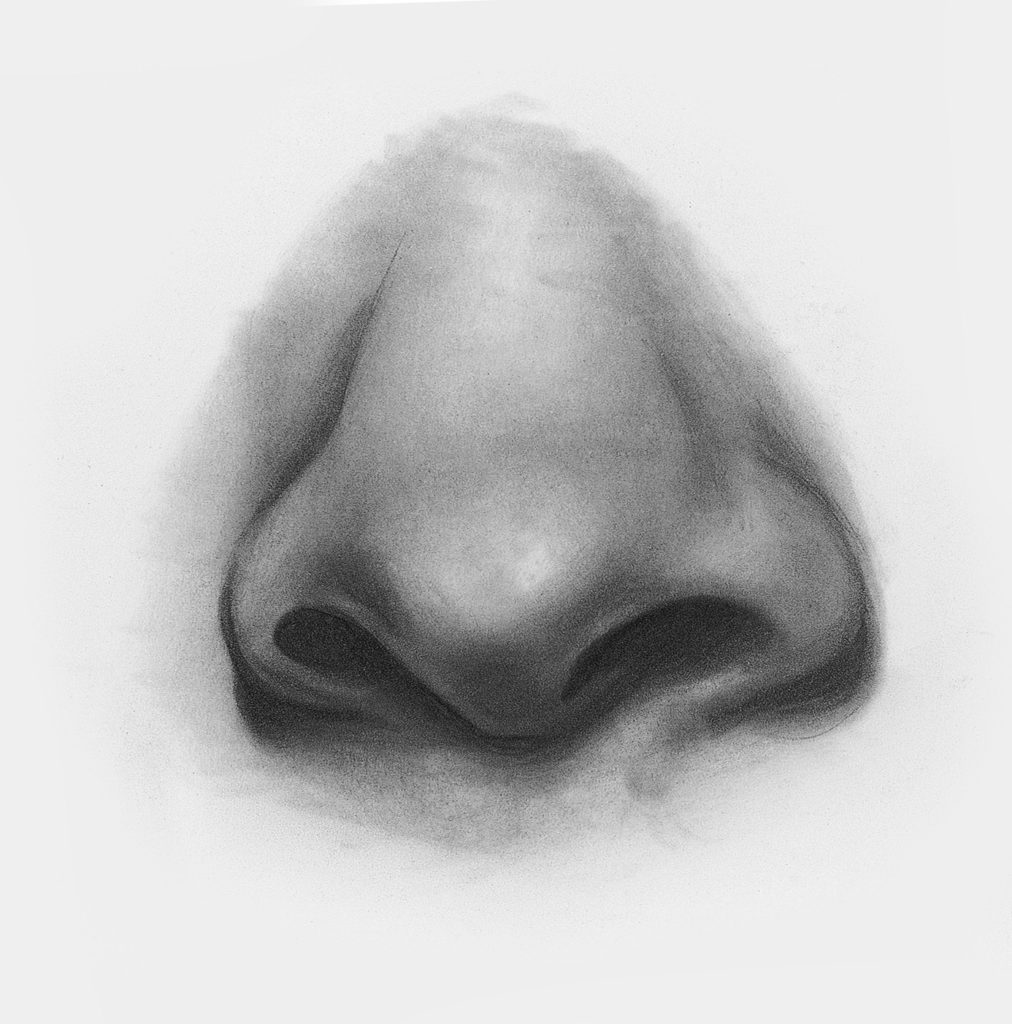
Drawing a Nose: Profile View
one. Create a Line Cartoon
Use the filigree method and a mechanical pencil to create a line drawing of a olfactory organ from a side view.
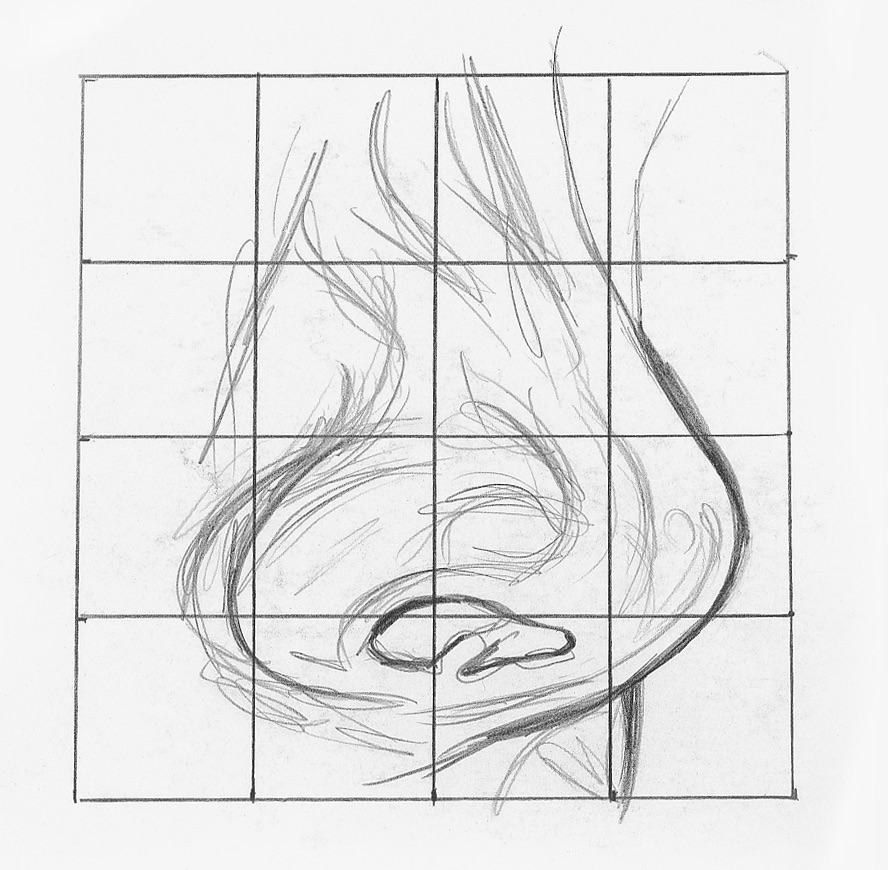
ii. Develop the Lights and Darks
When you are sure of your accuracy, carefully remove the grid lines with a kneaded eraser so develop the patterns of low-cal and dark with a pencil. Once again, be sure to refer to the sphere practise to render the tonal value variations of light shining.
iii. Blend
Blend the tones shine with a stump or tortillion. Use the dark tones behind the nose to brand the edges stand out.
Lighting is crucial. The dark groundwork makes this example expect very different from the previous one.
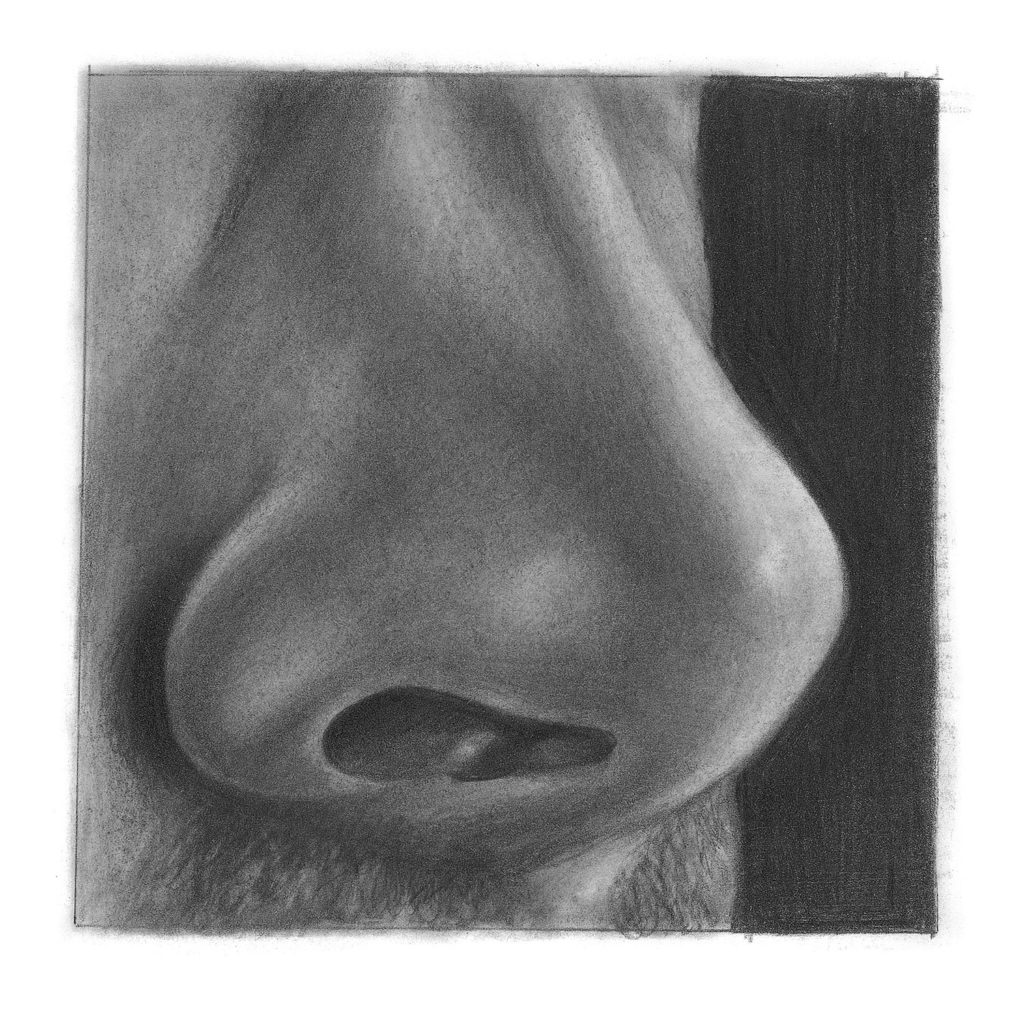
Video Lesson: How to Draw a Nose and Mouth
Drawing Male person and Female person Mouths / Lips
Cartoon a mouth can be a claiming, just you can describe realistic lips when you break the process into simple steps. Follow along to create a total, realistic mouth and avoid making unproblematic drawing mistakes, like defining difficult edges, that get-go artists tend to make.
When studying the oral fissure, you lot volition notice the upper lip is usually smaller and will appear darker than the lesser lip. It creates an Thou shape.
There are differences between male and female lips. Female mouths are much more defined and seem fuller and shinier. The edges of male lips are more subtle and are described past the shadows around them more than than the edges themselves.
Drawing Lips | Female
1. Create a Line Cartoon
Use the grid method and a mechanical pencil to create a line drawing of female person lips.
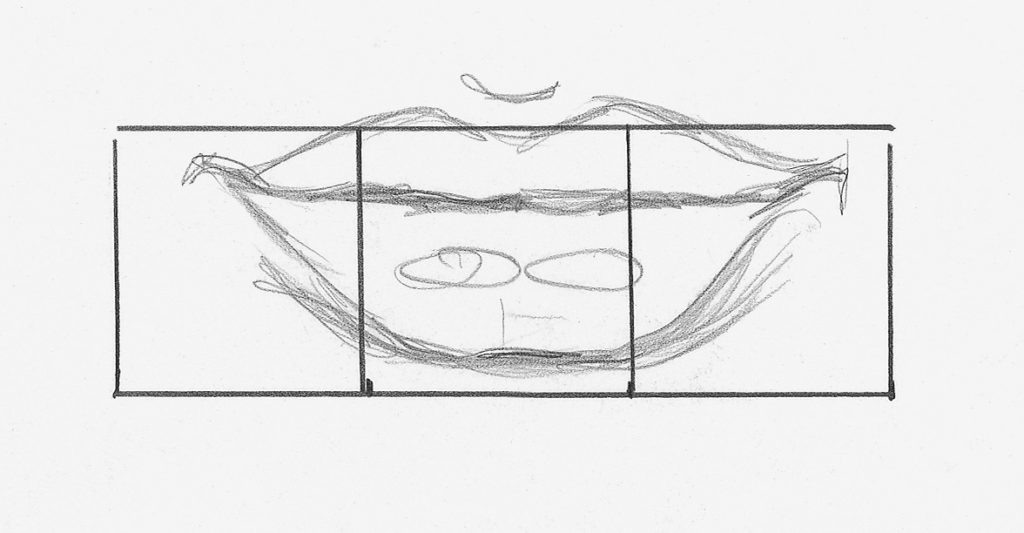
2. Apply the Dark Patterns
When you lot are sure of your accuracy, carefully remove the grid lines with a kneaded eraser. Use the dark patterns of the lips with a pencil.
Make the upper lip darker than the bottom one. This is because the upper lip angles in, and the lesser lip angles out.
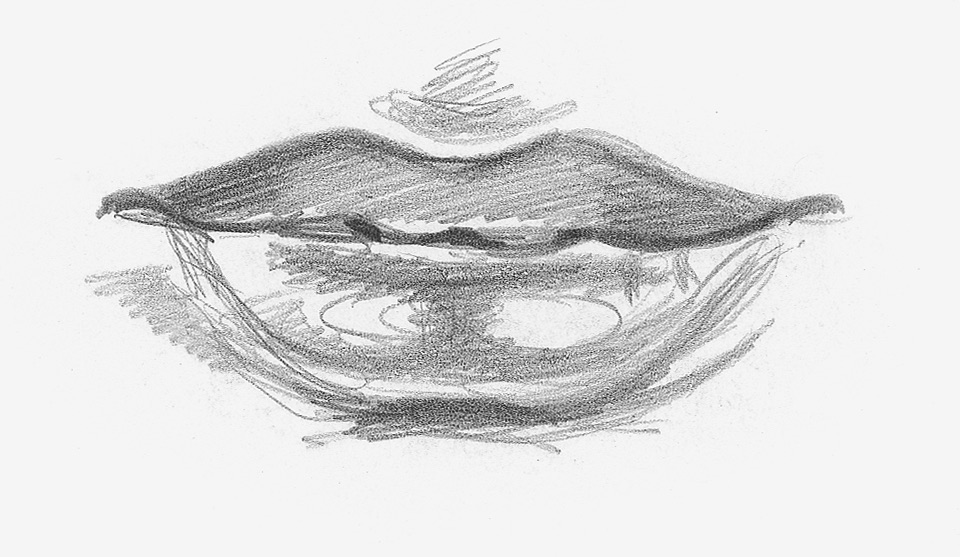
iii. Blend Tones and Light Highlights
Alloy the tones smooth with a tortillion. Be sure to create the tones of the pare effectually the lips so that they look realistic. Use a kneaded eraser to lift the bright highlights of the lower lip to make them wait moist and shiny.
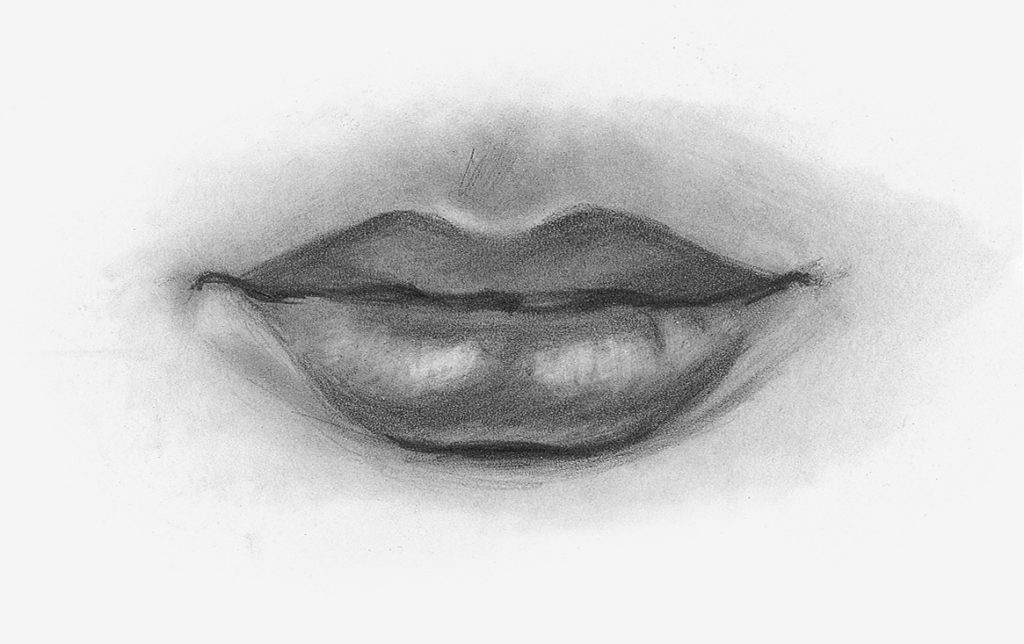
Drawing Lips | Male
1. Create a Line Cartoon
Use the grid method and a mechanical pencil to create a line drawing of male person lips.

two. Add together Dark Tones
When you lot are certain of your accurateness, advisedly remove the filigree lines with a kneaded eraser. Add together the darkest tones first with a pencil.
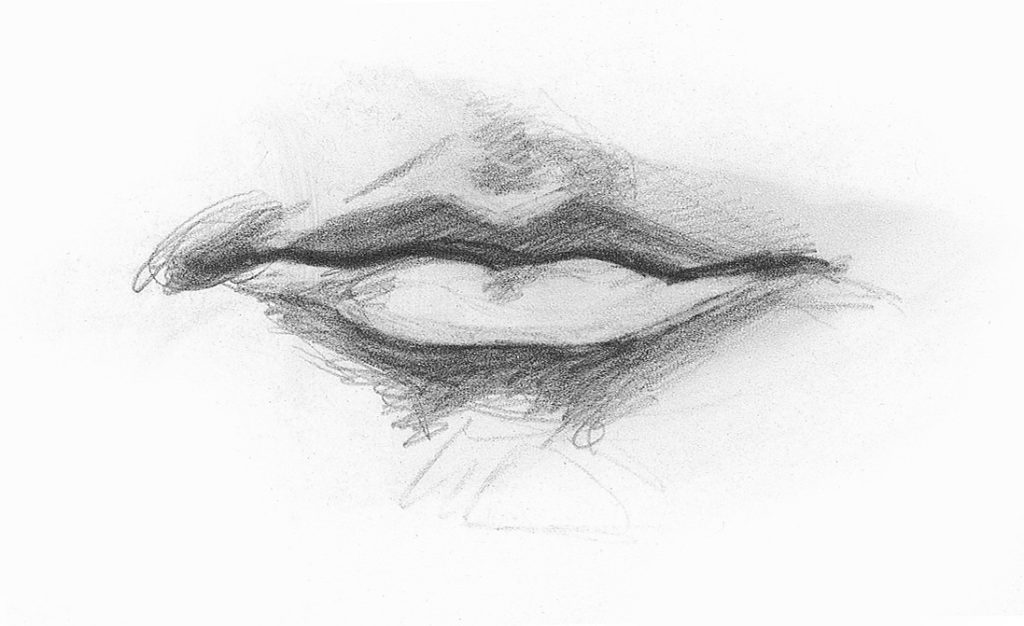
3. Alloy and Elevator
Blend the drawing with a stump or tortillion to remove the white of the newspaper. Deepen the dark areas with your pencil then lift light areas out with a kneaded eraser.
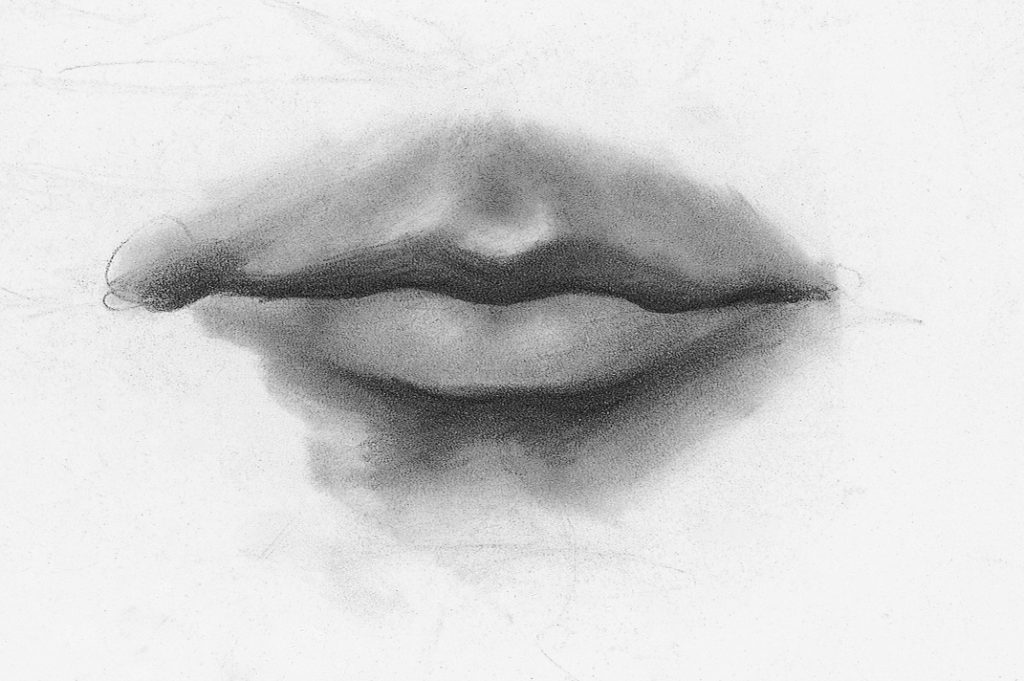
Drawing Smiles
Mouths become much more difficult to describe when the teeth are showing. When drawing teeth, never draw a hard line between each molar. Because the teeth touch, a hard line would make them look besides split up by representing a nighttime space.
They should also have some shading applied. Teeth are dimensional, so leaving them white would make them await flat. As the teeth recede into the mouth, the shadows get darker. The bottom teeth are always a bit darker too since they do non beetle as much.
1. Create a Line Drawing
Use the filigree method and a mechanical pencil to create a line drawing of a oral fissure and teeth. Each tooth must be perfect to create a adept likeness.
Do not describe difficult lines between each tooth. For accuracy, describe the shapes of the glue line and the edges of the teeth.
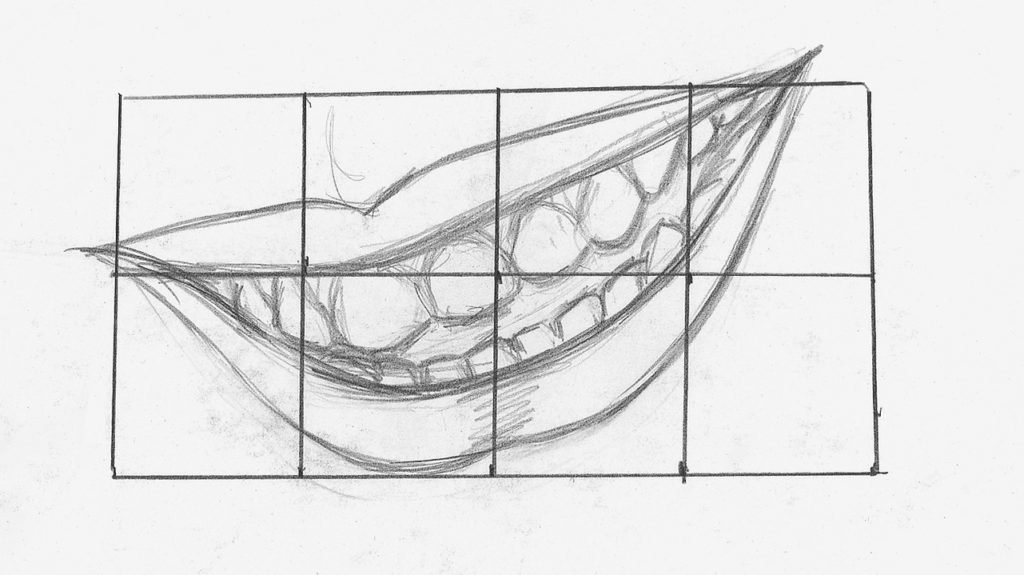
two. Employ Night Tones
When y'all are certain of your accuracy, advisedly remove the filigree lines with a kneaded eraser. Apply the darkest tones with a pencil. It is darkest inside the mouth. The upper lip is darker than the lesser lip and does not have bright highlights.
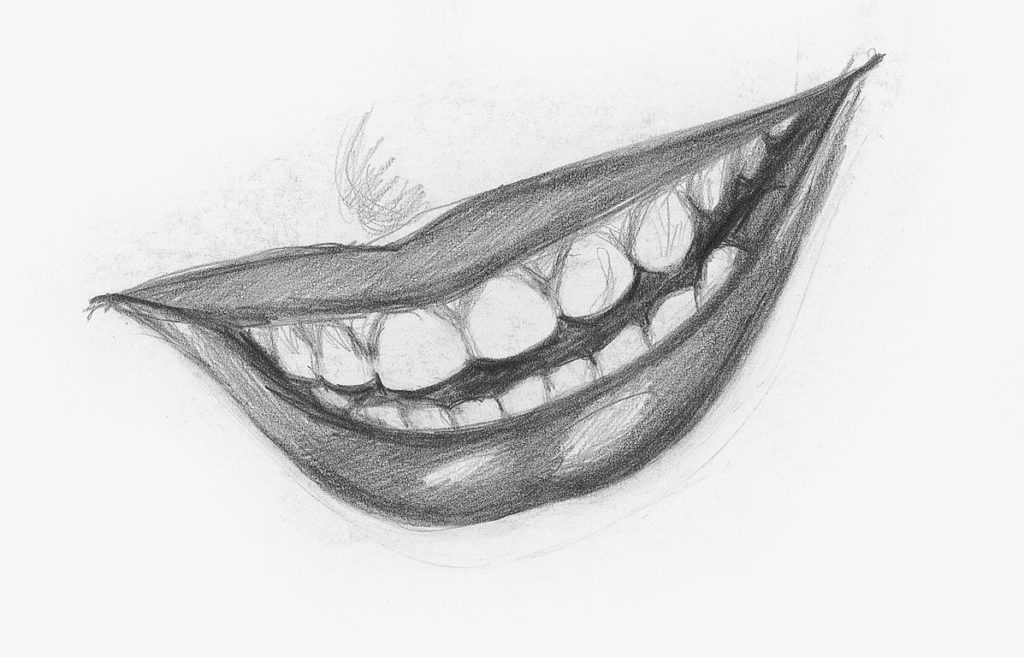
three. Blend, Add Shading and Lift
Blend the tones smooth with a tortillion. Use some shading to each tooth to brand certain they look dimensional. Lift the highlights of the bottom lip so that they look full and shiny.
Keep the lines betwixt the teeth subtle. Utilize a kneaded eraser to soften where they touch.
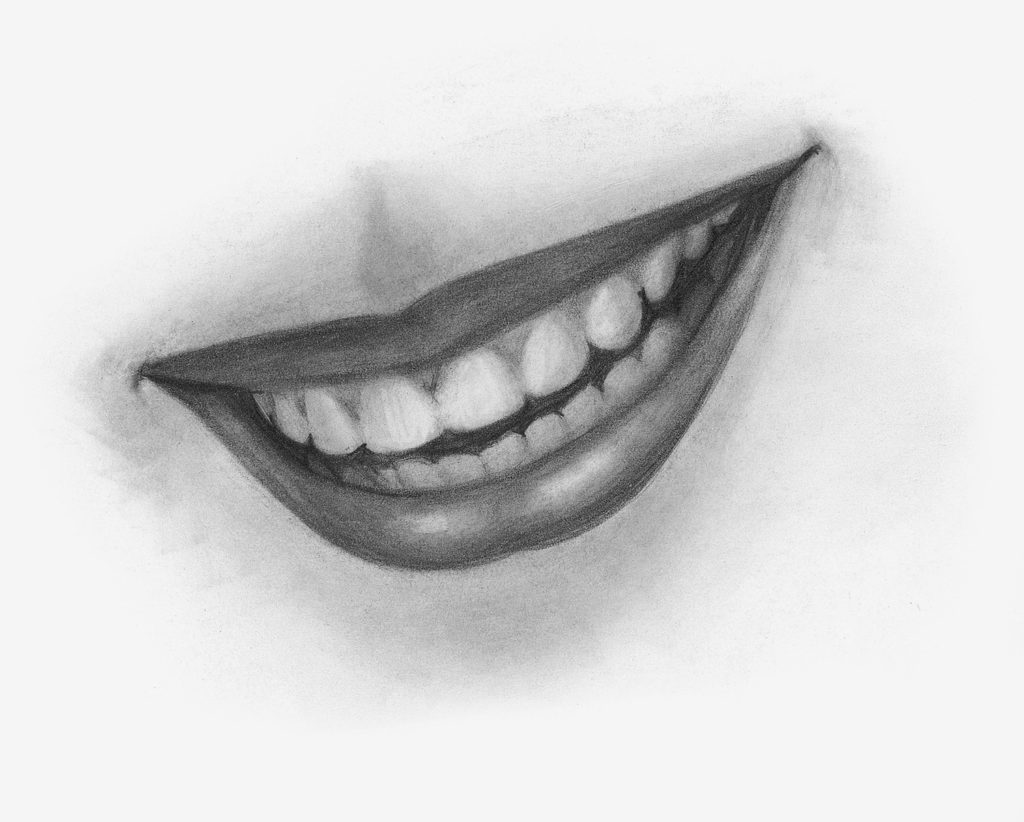
Cartoon Eyes
In that location are many components to the eye and all of them are of import. Hither are a few hints to assist you lot:
- The iris and the pupil are perfect circles when the center is looking straight at you lot. If turning away or looking up and down, they become ellipses.
- The pupil is ever perfectly centered within the iris.
- The educatee is the darkest part of the eye. Fill it in as dark and smooth as possible. Exit an area for a take hold of light.
- The catch low-cal should be half in the student and half in the iris. If the photo shows information technology blocking the educatee, motility information technology over.
- The lower lid thickness below the iris is very important. Never merely draw a line nether the eye. This small detail gives the middle dimension.
- Patterns within the iris volition vary depending on the colour of the eye and resemble a starburst.
- The white of the eye needs to be blended to resemble a sphere shape. Never just exit this surface area (the sclera) white.
- The lashes on the upper hat come together to brand a nighttime edge called the lash line.
- The upper eyelid recesses, making the eyeball have on a sphere shape.
Now permit'south movement on to drawing an eye.
i. Create a Line Cartoon
Use the grid method and a mechanical pencil to crate a line drawing of an eye.
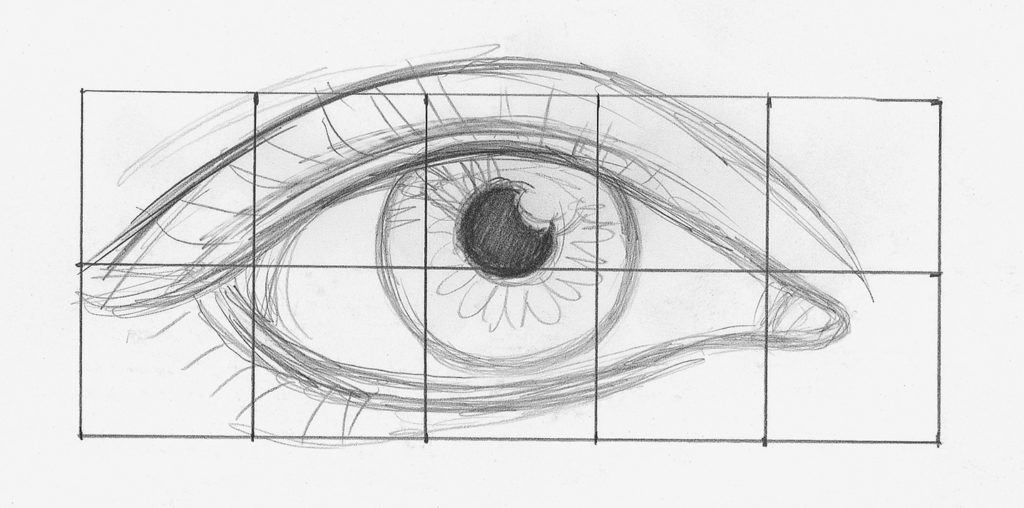
2. Lay in the Patterns and Alloy
When you are certain of your accurateness, advisedly remove the filigree lines with a kneaded eraser. Then, lay in the patterns of the iris with a pencil. Use pencil lines that resemble a starburst pattern or wagon bike spokes.
Leave an area open up for the catch light (half in the pupil and half in the iris). Blend things smooth with a tortillion. Use a kneaded eraser to lift the catch calorie-free and increase the patterns in the iris.
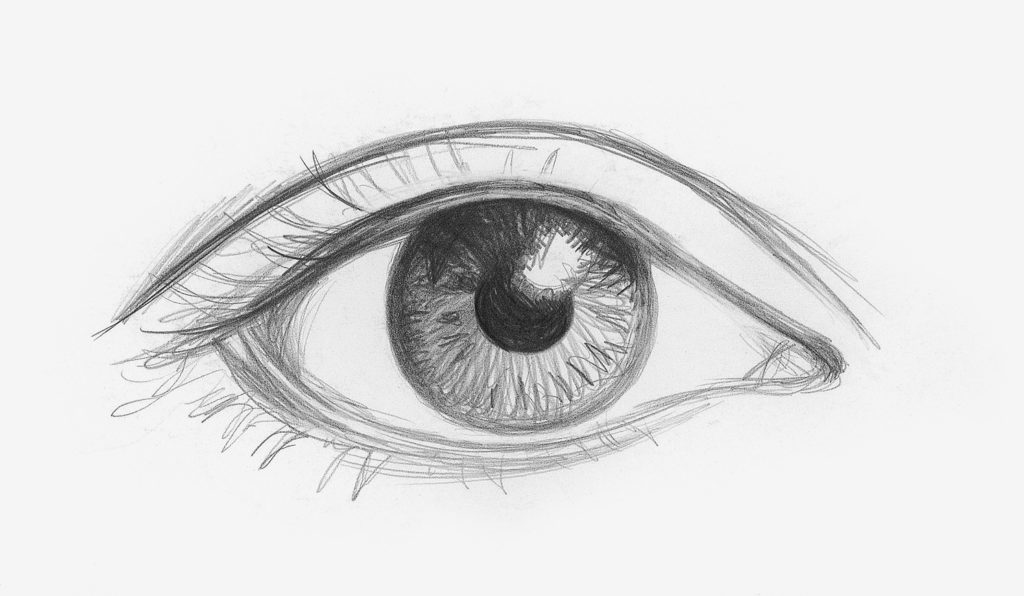
three. Continue Blending and Shading, Add together Eyelashes
Blend the skin areas of the cartoon to create the form and contours. Shade the white of the centre to make it expect rounded similar a sphere.
Add the eyelashes with very quick strokes that taper at the ends. They grow in layers and clumps, and so do not make them go all along in a row.
Detect how the lashes on the lesser abound from the lower edge of the lower lid thickness. You can run across how much dimension the lower lid thickness gives to the await of the center.
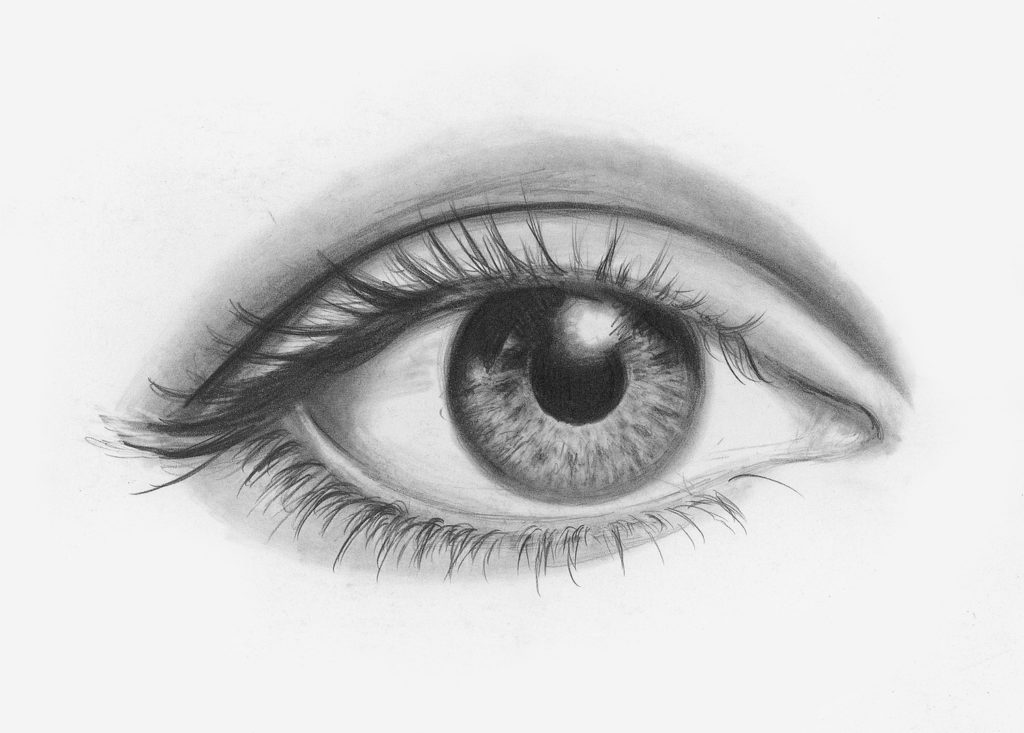
Video Lesson: How to Describe an Eye
In this episode of our live weekly Cartoon Together series, artist Scott Maier shows how to draw an eye.
Drawing Noses and Eyes Together
Once yous learn the beefcake of the centre and how to draw it realistically, information technology is important to understand how to put two of them together along with other facial features like the nose. Here are some guidelines to remember:
- The space between the eyes is i eye width.
- Both eyes should be straight across from each other.
- If you draw a vertical line downwardly from the corner of the centre, it will line upwardly with the edge of the nose. (This can change according to different ethnicities.)
- Both eyes must exist looking in the same direction. The pupil and iris must be the same in both.
- Identify the grab light in the same place on both eyes (half in the student, half in the iris).
ane. Create a Line Cartoon
Use the grid method and a mechanical pencil to create a line cartoon of a olfactory organ and eyes together. Observe how the vertical line fatigued downwards from the corner of the optics lines up with the border of the olfactory organ. Identify the optics direct across from one some other.
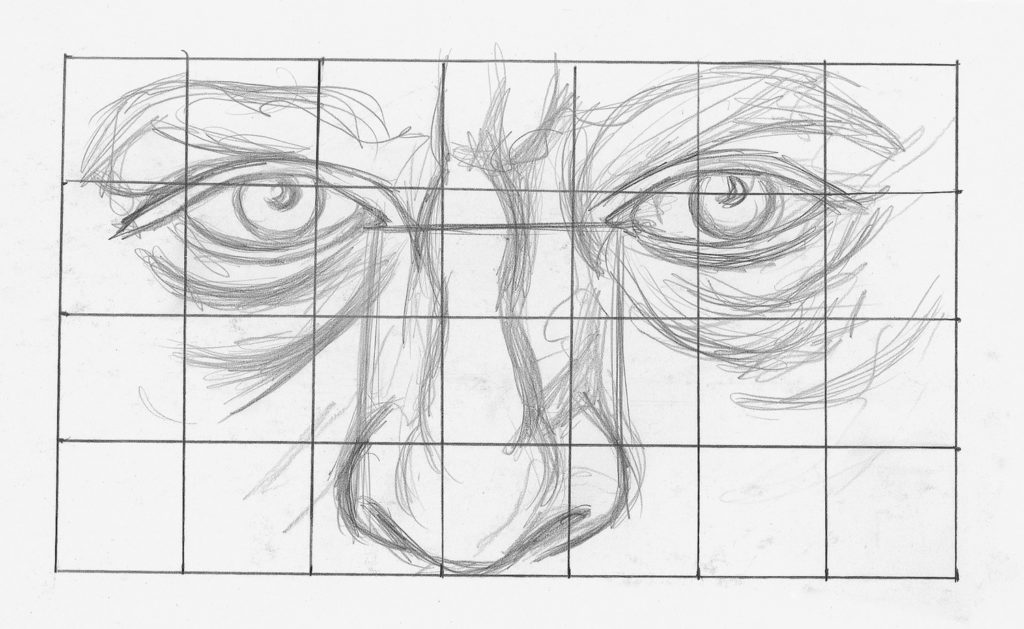
two. Use Dark Tones, Fill in the Shadow Areas and Eyebrows
When y'all are sure of your accurateness, carefully remove the grid lines with a kneaded eraser. Apply the darkest tones with a pencil.
The pupils of the optics are the darkest areas. Make full in the tones of the shadow areas and the eyebrows. The eyebrows should be shaded in as a shape showtime, before the hairs are applied.
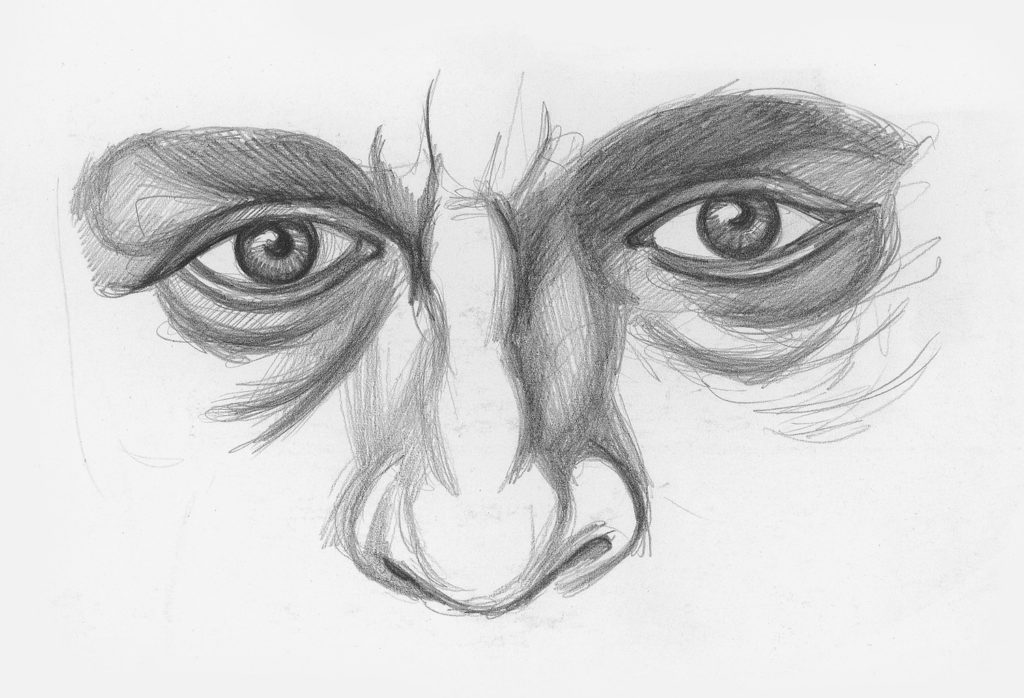
three. Blend and Apply Highlights
Blend with a stump or tortillion. Very lilliputian of the paper should exist left white, even in the whites of the eyes. Utilise a kneaded eraser for the small highlights seen in the brows and patterns within the pupils.
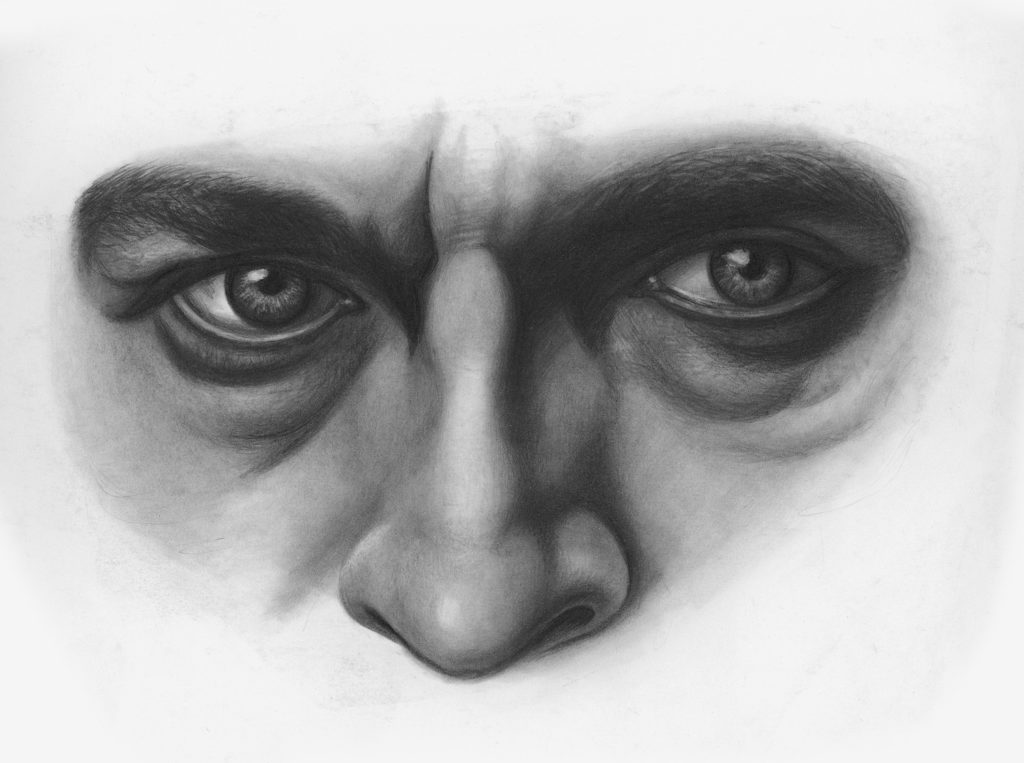
Cartoon Eyes from an Angle
This project will help yous come across things from a dissimilar vantage point. When you lot draw facial features of a person who is at an angle, the rules change.
The features wait distorted due to the perspective. In this view, the contour of the nose is blocking one of the eyes and only a small portion of the face is showing on that side.
one. Create a Line Drawing
Apply the filigree method and a mechanical pencil to create a line drawing of optics in a slightly angled pose. Notice how this angle blocks the view of part of the face.
The irises and pupils now are vertical ellipses, since the eye is not looking straight at you. The perfect circle is now changed due to the perspective.
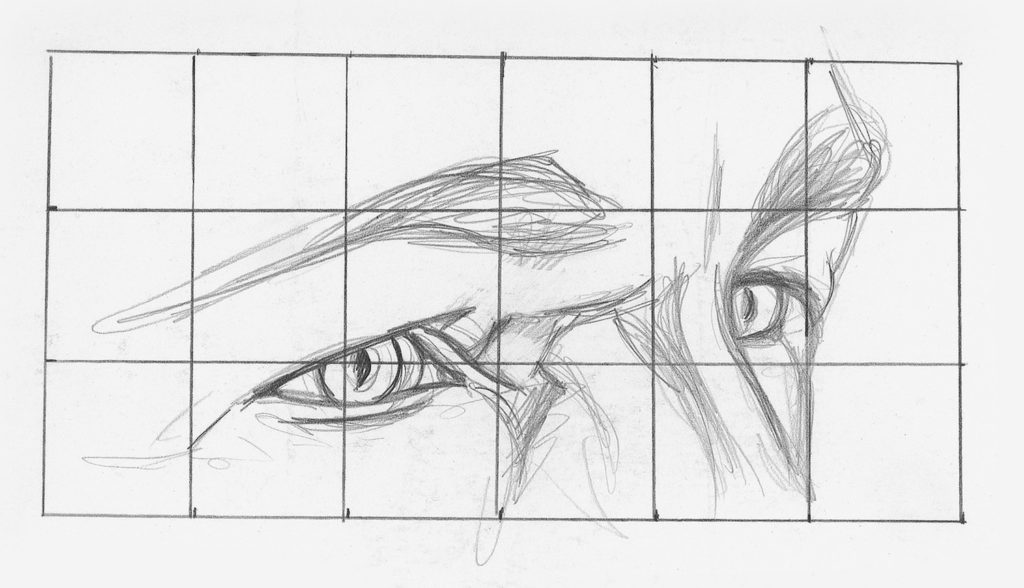
two. Utilize Darks, Add Shadows and Blend the Eyebrows
When you are sure of your accuracy, carefully remove the grid lines with a kneaded eraser. Utilise the darkest tones with your pencil to create the shadows. The pupils of the eyes are the darkest areas. Blend the shapes of the eyebrows to a greyness tone.
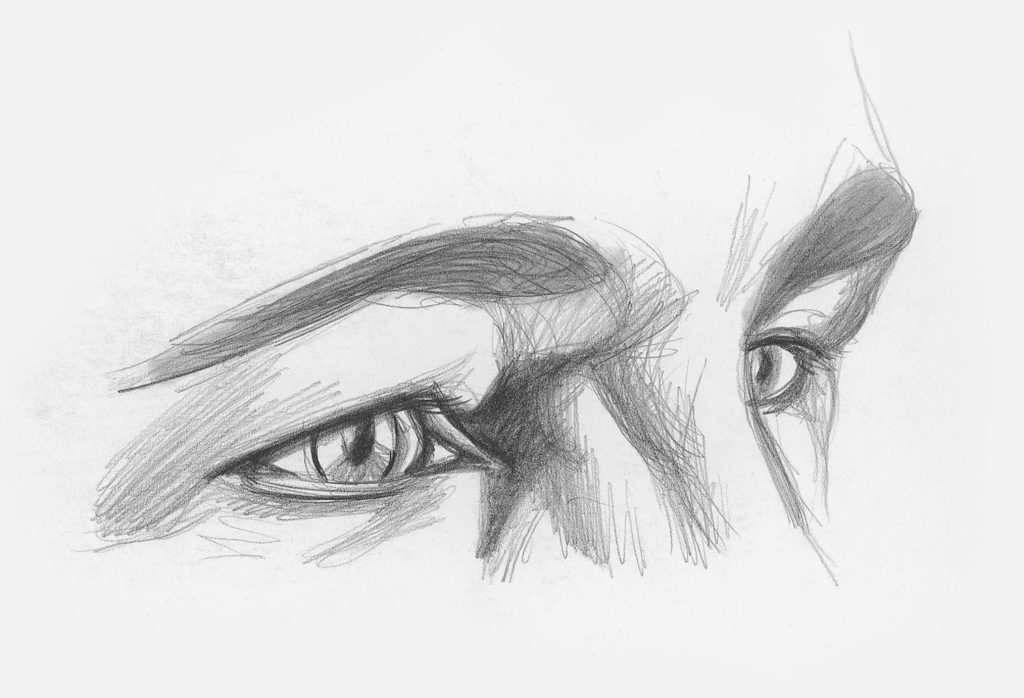
iii. Blend and Lift
Blend the pare areas with a stump or tortillion. Utilize a kneaded eraser for the pocket-sized highlights seen in the brows. Create the patterns within the pupils and lift the take hold of lights.
Drawing Ears
Ears are ane of the virtually difficult features to describe because hey are fabricated upward of strange shapes. Nosotros don't particularly pay much attention to ears unless they have earrings or are larger than normal. Either way, they are not shapes that we often retrieve well-nigh.
To describe a expert portrait, you must larn the beefcake of the model to make them expect disarming. It is a good idea to practise drawing ears in a diverseness of angles and poses, as well. Practicing all views is important if y'all want to be proficient in portrait drawing.
Video Lesson: How to Draw an Ear
In this episode of our weekly live Drawing Together series, artist Scott Maier shows how to draw an ear.
Drawing Ears: Forepart View
This is a typical front view of an ear seen on a portrait. Much of the anatomy is blocked by the hair. Just the protruding part of the earlobe is visible.
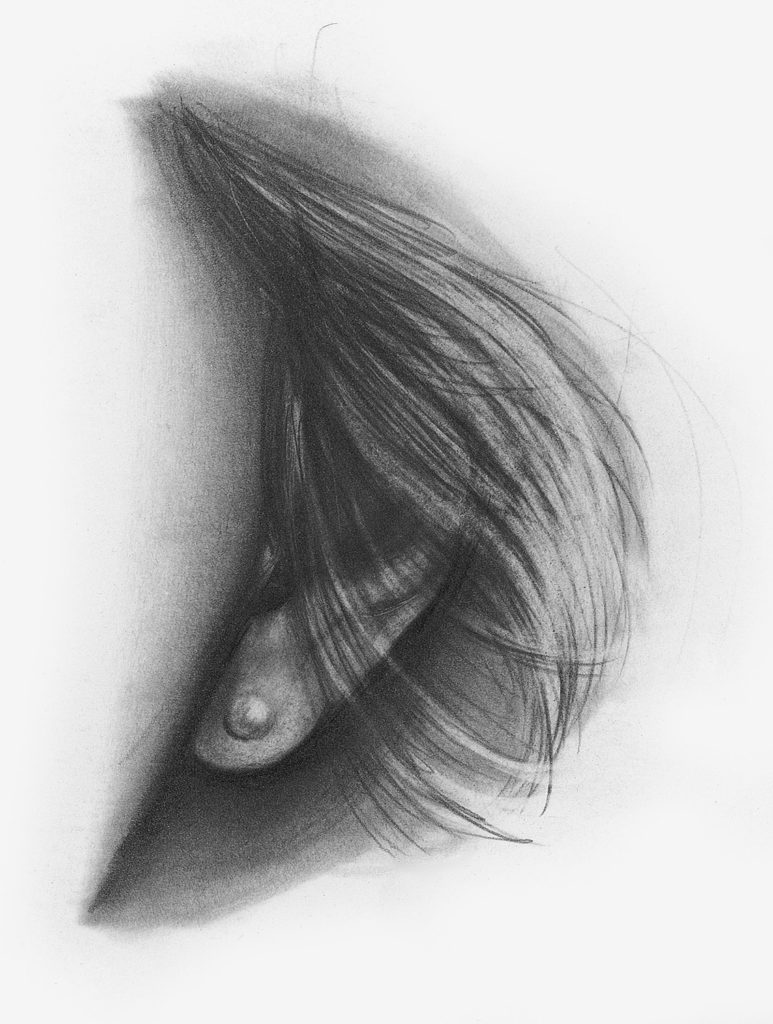
Drawing Ears: Side-Bending View
This side-bending view shows the complexities of the ear. It is certainly not a typical pose, but you never know when you may have to depict a person in an unusual pose.
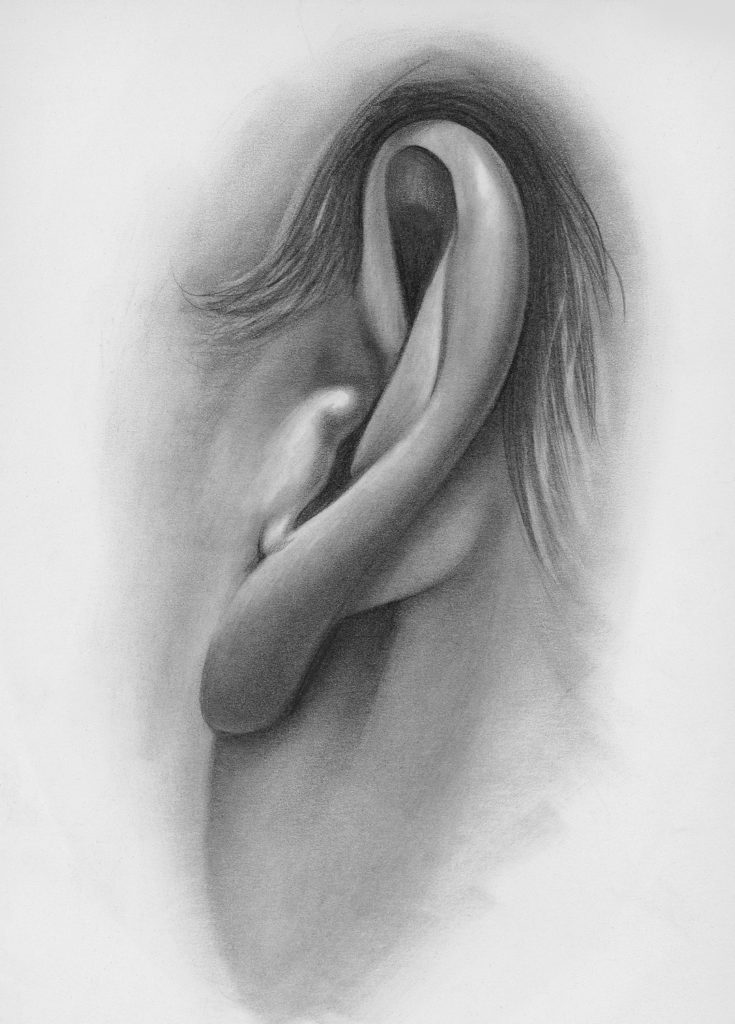
Cartoon Practise: Learning the Anatomy of Ears
This exercise will assistance you larn the anatomy of ears. They are fabricated up of many intricate shapes that all nestle together. The filigree method helps to make them announced more than like a puzzle.
Here are some things to continue in mind when drawing ears:
- The outer ear overlaps the inner ear.
- The inner ear has an area that resembles a Y. Wait for information technology in every ear you depict.
- The peel of the ear is different. It is more oily, and then highlights tin can announced very bright.
- There is a protruding area of the inner ear that acts like a cup.
- The earlobe frequently resembles a sphere.
1. Create a Line Drawing
Use the grid method and a mechanical pencil to create a line drawing of an ear. Look at it like a puzzle of interlocking shapes.
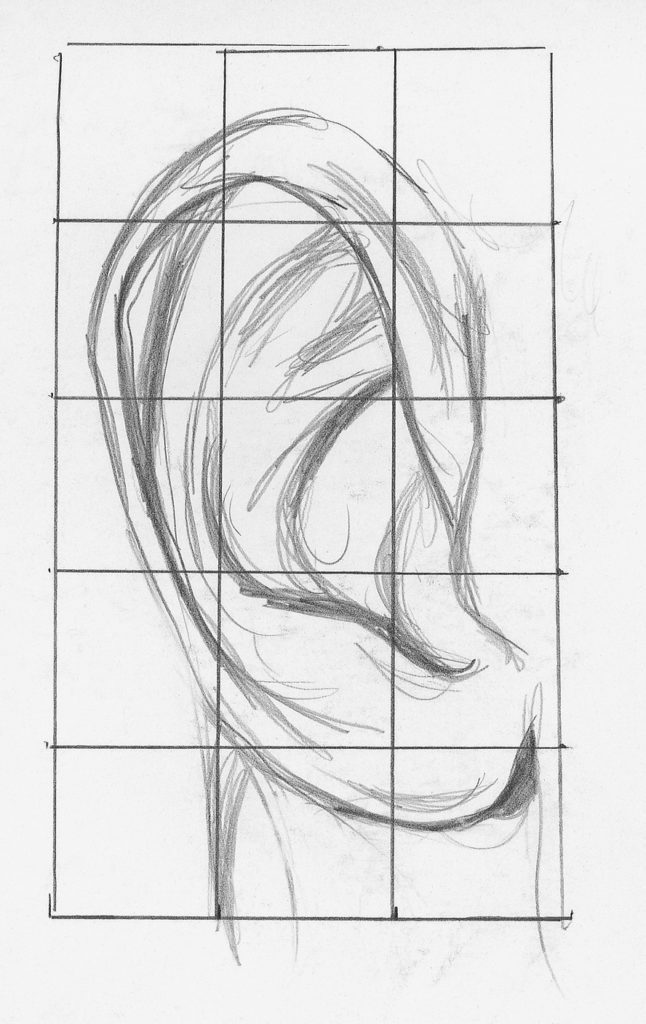
two. Apply the Darks
When you lot are sure of your accuracy, carefully remove the grid lines with a kneaded eraser. Use the darkest areas with a pencil.
Create shadows underneath where the outer ear overlaps the inner ears. Resist the urge to outline besides much. Let shading create your edges.
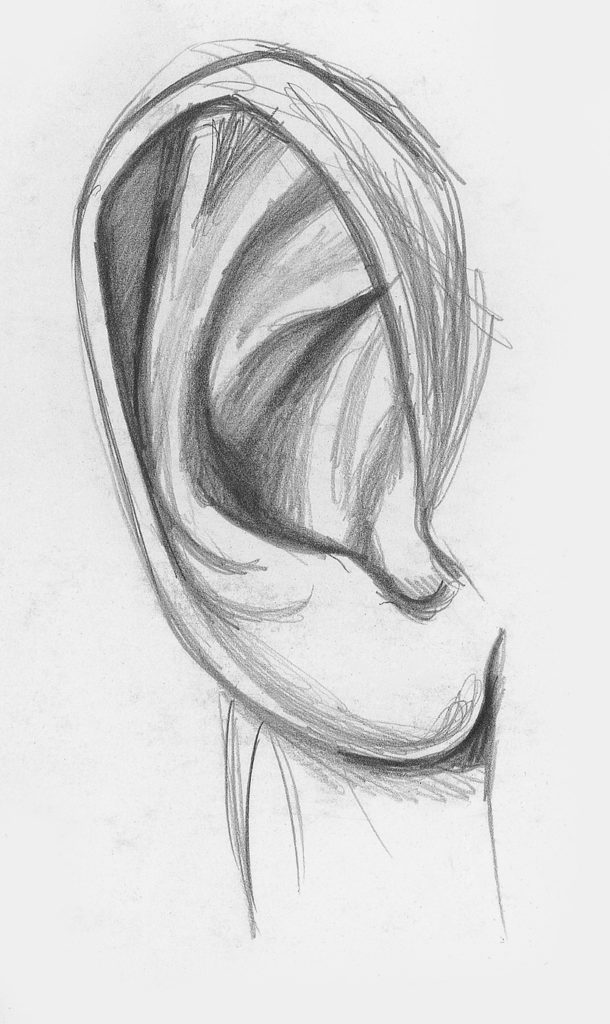
3. Blend and Lift
Alloy the drawing with a stump or tortillion. To get in look realistic, lift out highlights with a kneaded eraser.
The ear is a fleck shinier than other peel, so the highlights should exist bright. Recollect the five elements of shading and the sphere when focusing on the earlobe.
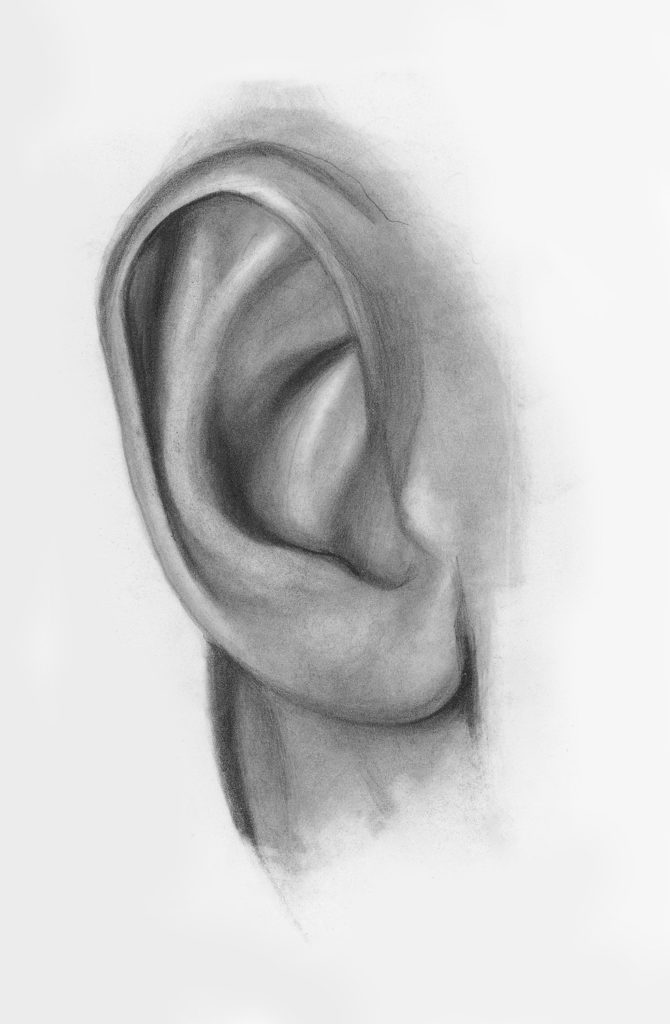
Putting It All Together | Drawing a Portrait
Now that you lot've learned how to depict facial features from the eyes to the oral fissure, information technology'southward time to put everything together into a portrait. Do non practice this project before you have done the proper practice work. Become back and exercise all of the facial features get-go.
And, before moving on, be certain to practice cartoon hair.
Video Lesson: Drawing a Woman's Portrait
In this episode of our weekly live Cartoon Together serial, creative person Scott Maier shows how to describe a adult female's portrait.
Here are some tips for cartoon portraits:
- When you want to draw facial features, kickoff with the optics. This helps create a connection with the viewer and starts to capture the personality of your subject.
- When you lot finish the eyes, move down and finish the nose, then the mouth. This is chosen the triangle of features.
- Allow the darkness of the pilus to help create the lighter edge of the face. Placing tone behind the face reduces the chance of things looking outlined.
- When drawing pilus, apply your pencil strokes going in the aforementioned management as the pilus growth.
- Ever recall the five elements of shading with everything you draw.
How to Draw a Portrait
1. Create a Line Drawing
Apply the filigree method and a mechanical pencil to create a line cartoon of a female face. Go one box at a time and be very conscientious with the shapes.
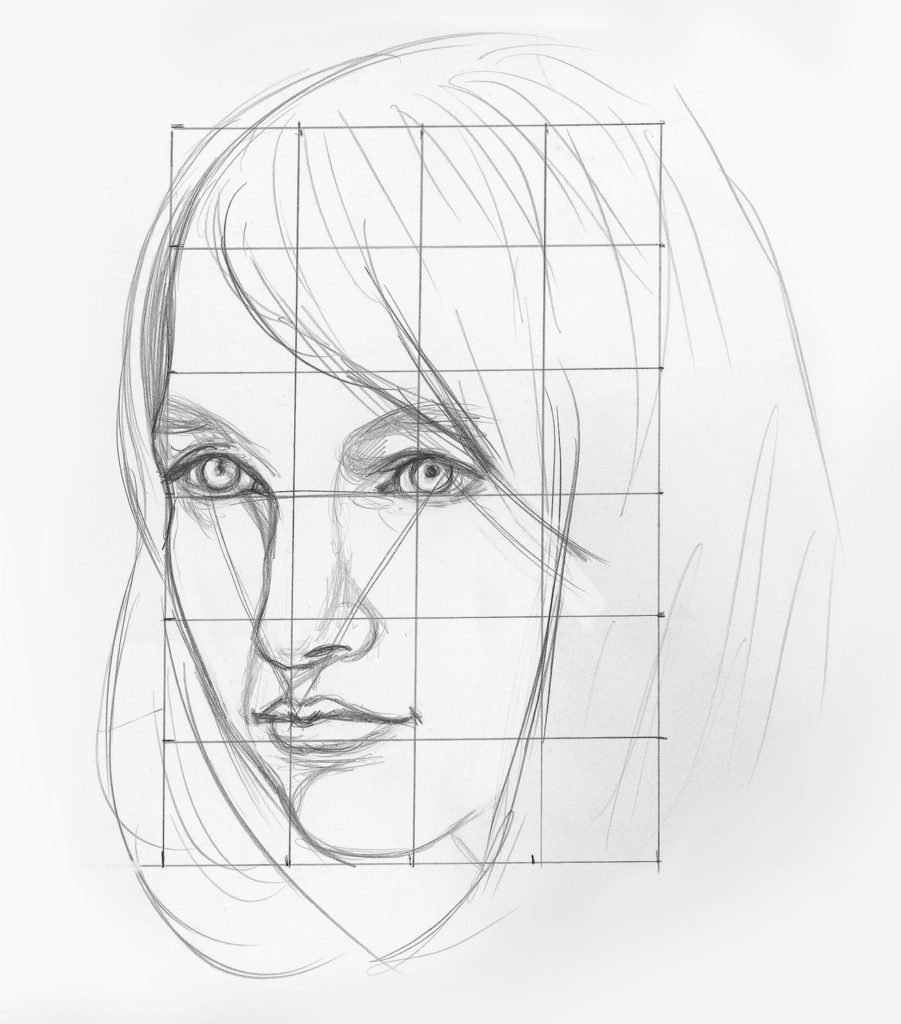
two. Apply the Darks and First Building up the Hair
When you are sure of your accuracy, carefully remove the grid lines with a kneaded eraser. Apply the darkest tones.
Start with the eyes so motility down to the nose and mouth to create the triangle of features. Apply some nighttime tone next to the face to help create the light border of the face. Beginning to build the hair using long pencil strokes.
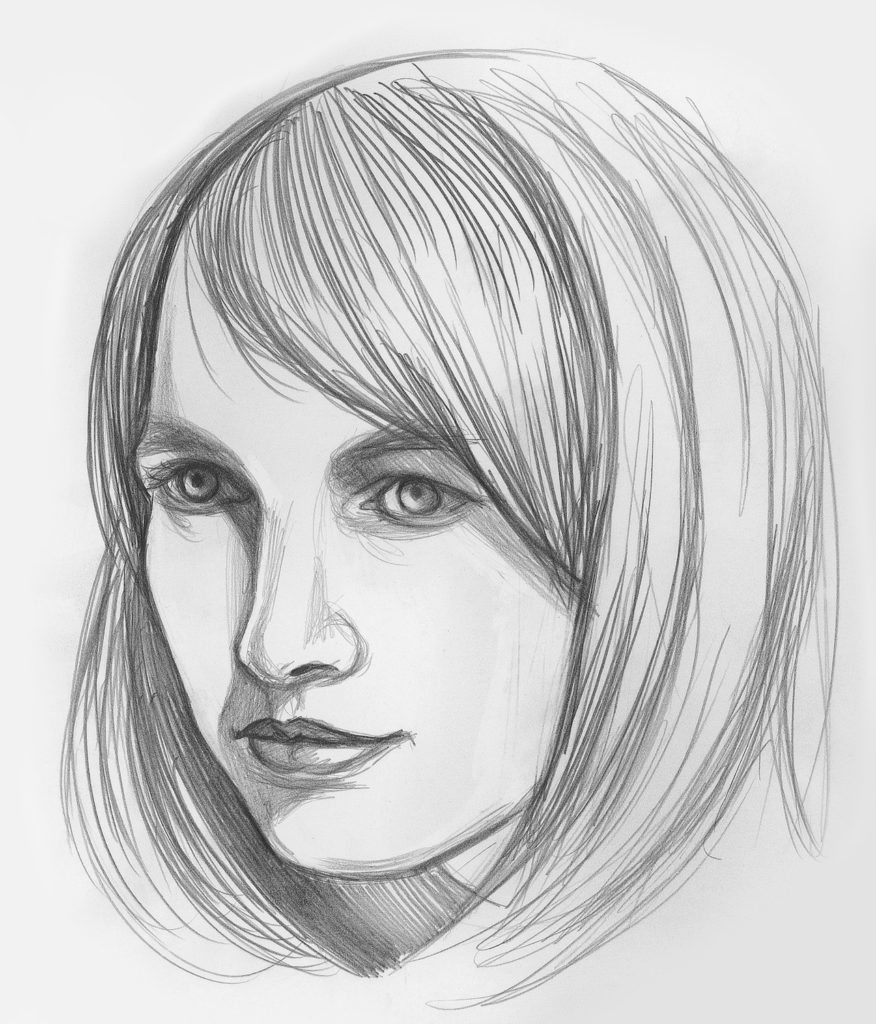
3. Blend and Lift
Take your fourth dimension finishing. The face must be blended very smooth with a stump or tortillion. Piffling of the drawing should be left pure white; only the highlights in the optics and on the nose appear white. Equally you lot complete the face, refer to the previous exercises on private facial features and go on the 5 elements of shading in mind.
The pilus in this portrait takes a lot of time. Use very long pencil strokes to create the length. Blend everything out smoothen and then lift bands of light out of the pilus with a kneaded eraser.

Keep Practicing
Now that you have learned how to describe facial features, keep practicing! Lee Hammond'south All New Big Volume of Drawing includes tons of quick step-by-stride drawing demos geared toward beginners in both graphite and colored pencil, including how to draw facial features in colored pencil. You can besides detect more than inspiration and techniques from Lee Hammond on her website.
Learning to Draw? Join Our Live Video Series, Drawing Together!
Learn to draw faces, people, and much more in our alive weekly video series led by creative person Scott Maier.
How to Describe an Eye How to Draw a Nose and Oral cavity
Drawing a Girl's Portrait Drawing a Self Portrait
Source: https://www.artistsnetwork.com/art-mediums/drawing/beginners-guide-draw-facial-features/
Posted by: burkeknearot.blogspot.com

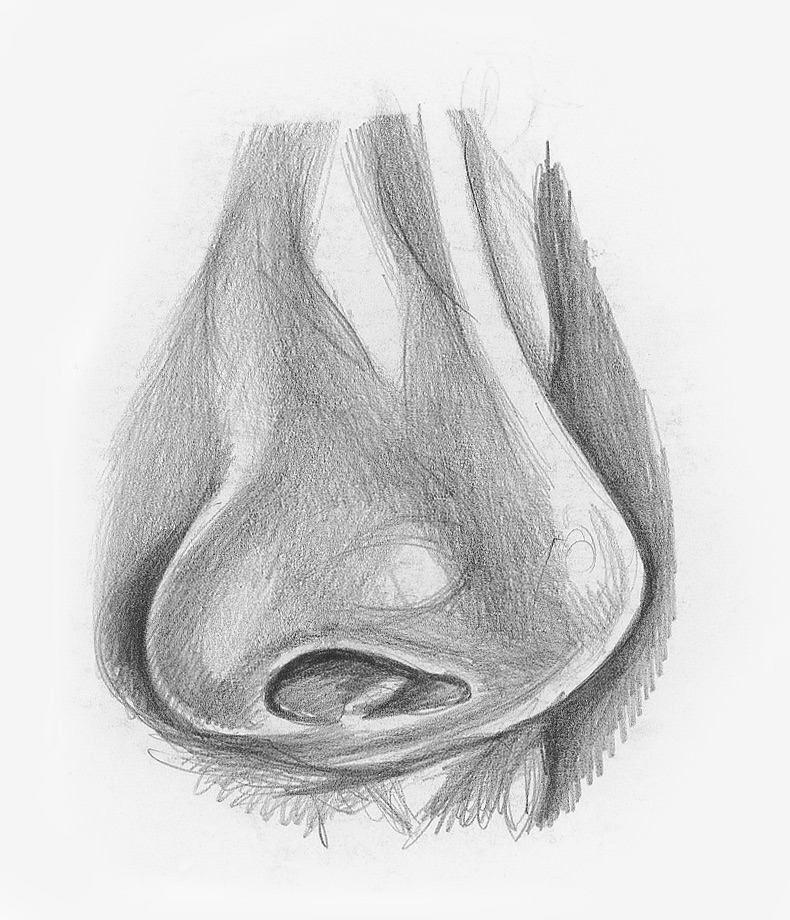
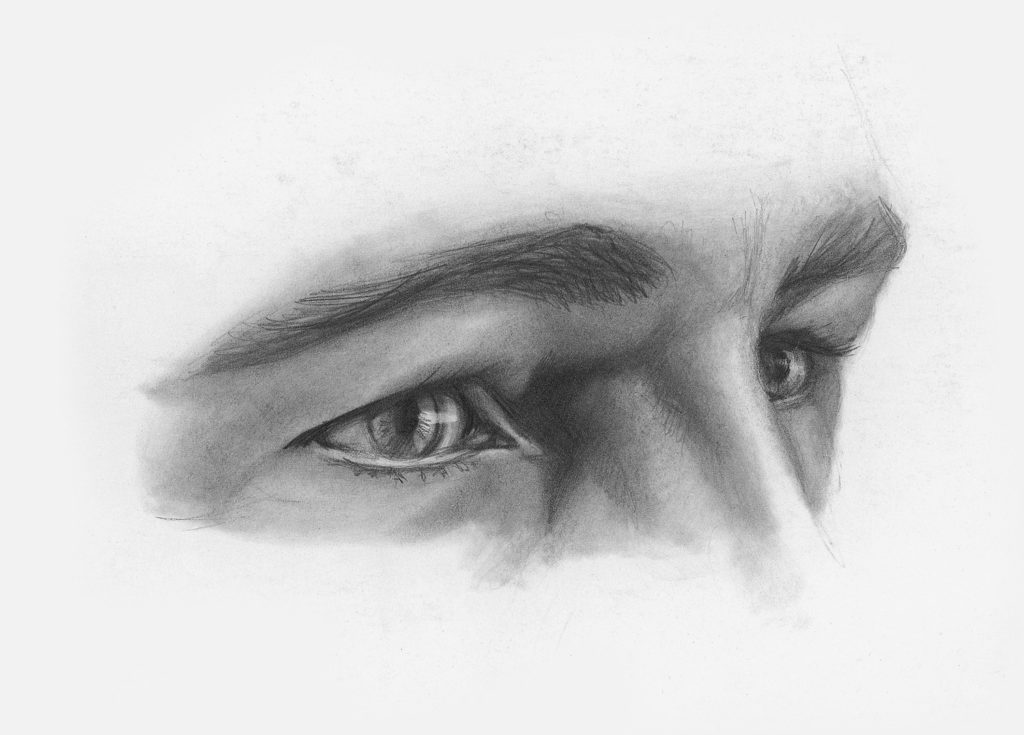

0 Response to "How To Draw A Great Dane Face"
Post a Comment